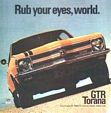The next generation of Toranas (LC) appeared in October 1969 and were available with either a four or six cylinder engine. The inline six had a capacity of 138 in³ (badged as the '2250'). The six-cylinder cars had a slightly longer nose to accommodate the larger engine, and offered a choice of three and four-speed manual gearbox or a three-speed Trimatic automatic transmission. The Torana was Wheels magazine's Car of the Year for 1969.
Body styles were all new and available in either two or four doors, and were offered in S or SL trim. Bench or bucket front seats were also an option, along with disc front brakes. A more-powerful 161 in³ engine (badged as the '2600') was made available soon after the model's release in the more upmarket SL and in the two-door sports model, the GTR, as a 2600S with a two-barrel Stromberg WW carburettor. Later in production, the 161ci engine was replaced with a larger 173ci version (badged as the '2850') which also made it into the last of the LC GTR cars in two-barrel form.
In 1970 the first genuine performance Torana, the GTR XU-1, was developed by Holden along with Harry Firth of the Holden Dealer Team for competition in popular Series Production racing series in Australia as well as in off-road rallying. However, the main purpose of the Torana GTR XU-1 was to keep Holden competitive against the big and powerful Ford Falcon GT-HO V8s in the Hardie-Ferodo 500 (Bathurst) endurance race that is considered to be the jewel in the crown of Australian motorsport.
The LC Torana GTR XU-1 was equipped with a 160 brake horsepower 186 in³ (3 litre) six cylinder engine, fitted with three Zenith Stromberg CD-150 carburettors, cast iron headers, a performance cylinder head and camshaft and an Opel four-speed manual gearbox. This car featured a rear spoiler, guard flutes, wider steel rims, full instrumentation and front disc brakes as standard. The Torana GTR XU-1 proved to be a 'pocket rocket' both on the road and track, as this lightweight, high-performance sports coupe' had an excellent power/weight ratio. It soon gained huge popularity in Australia, being an ideal race car in all forms of motor sport, especially Series Production touring car racing and rallying. It successfully replaced the V8 Monaro GTS 350 as Holden's frontline track race car in 1970, winning many touring car and rally events, but for the famed Bathurst 500 mile race which Ford won in 1970 and 1971 with its XW Phase Two and XY Phase Three Falcon GT-HOs respectively.
| Production |
1969–1972 |
| Body style(s) |
2 door sedan |
| |
4 door sedan |
| Engine(s) |
1.2L OHV I4 |
| |
1.6L OHC I4 |
| |
130 / 2.1L OHV I6 (Export motor) |
| |
138 / 2.25L OHV I6 |
| |
161 / 2.6L OHV I6 |
| |
173 / 2.85L OHV I6 |
| |
86 / 3.0L OHV I6 |
|

|


